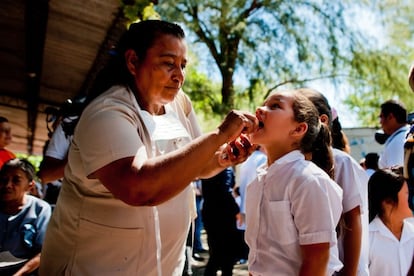Central America on alert for new epidemic
Mosquito-borne chikungunya virus causes fever and intense joint pain that can last for years


Central America is on alert over the imminent spread of the chikungunya virus, better known as the virus of pain.
Originally from Africa, the viral disease has quickly spread across the planet. The latest propagation area is the Caribbean, where two cases were detected in December 2013. Six months later, and that figure is up to 5,200 confirmed cases (including 21 deaths), with 183,000 more under scrutiny.
From there, the virus has just made the jump to American territory: El Salvador has already registered 1,200 cases, Cuba has admitted to six this week, and Panama to another two.
Faced with the upcoming onslaught, Mexico has beefed up its detection network, Venezuela has deployed checks at seaports and airports, Guatemala has declared a preventive health alert, Honduras has begun creating fast response teams, and Costa Rica and Nicaragua are working on the premise that the virus will make an appearance any day now.
The virus is transmitted to humans by infected mosquitoes, and while the fever is rarely deadly, it causes strong pain in the joints and muscles, which can sometimes last for years.
There is no way to stop chikungunya from entering; we can’t throw a mosquito net over an entire country” Costa Rican health official
It was detected as early as 1770, but for a long time was confused with dengue fever. Then, in 1952, it was isolated for the first time in Tanzania, where it received the Bantu name of chikungunya, which means to become contorted — it’s a name that leaves no room for doubt as to its painful effects.
The disease also comes with nausea, deep fatigue and skin rashes, leaving patients barely able to get up from bed. The risk of death is exponentially higher for older people and newborns.
There is no effective cure for chikungunya, and treatment is limited to symptom relief.
One of the biggest hurdles to eradicating the virus lies in the fact that there are two different types of mosquito carriers: Aedes aegypti, which causes yellow fever, and Aedes albopictus, also known as the tiger mosquito. Their living range includes everything from tropical climates to temperate and even cold areas, and their working hours are long: they attack from sunup to sundown, whether indoors or outdoors.
The World Health Organization (WHO) has epidemiological maps showing that the virus has expanded at the same rate as globalization. From Africa it first jumped to southern Asia.
“Since 2005, India, Indonesia, the Maldives, Myanmar and Thailand have reported more than 1.9 million cases,” notes the WHO.
This is a new disease, but we are ready for battle”
El Salvador Health Minister Violeta Menjívar
Europe has also felt the effect, though less powerfully, via the tiger mosquito. In 2007 Italy treated nearly 200 cases, while the Spanish northeastern region of Catalonia reported eight imported cases in the last month.
But the great new expansion zone is the Americas. El Salvador leads the statistics with 1,200 cases and a systematic fumigation plan.
“We are dealing with a new disease, but we are ready for battle,” said Health Minister Violeta Menjívar. The reason for this fast propagation, experts note, is the strong presence of the tiger mosquito in the country, as well as the fact that the Salvadoran population lacks any immunological barrier for a completely new disease.
But Central American nations will have trouble containing the viral disease due to their physical proximity to chikungunya’s headquarters in the Americas: the Caribbean. Over 150,000 cases have been reported this year in Dominican Republic, Haiti, the Martinique and Guadaloupe, with 4,000 of these confirmed, according to the Panamerican Health Organization.
As soon as a mosquito bites an infected patient, it becomes an airborne transmitter of the disease.
“There is no way to prevent chikungunya from entering the country; we cannot throw a mosquito net over an entire country. There are hundreds of flights between Costa Rica and Caribbean countries,” said a high-ranking official from the Costa Rica health service.
From Central America, it is only one step to the United States, which has already registered 80 cases, though none on the mainland.
Tu suscripción se está usando en otro dispositivo
¿Quieres añadir otro usuario a tu suscripción?
Si continúas leyendo en este dispositivo, no se podrá leer en el otro.
FlechaTu suscripción se está usando en otro dispositivo y solo puedes acceder a EL PAÍS desde un dispositivo a la vez.
Si quieres compartir tu cuenta, cambia tu suscripción a la modalidad Premium, así podrás añadir otro usuario. Cada uno accederá con su propia cuenta de email, lo que os permitirá personalizar vuestra experiencia en EL PAÍS.
¿Tienes una suscripción de empresa? Accede aquí para contratar más cuentas.
En el caso de no saber quién está usando tu cuenta, te recomendamos cambiar tu contraseña aquí.
Si decides continuar compartiendo tu cuenta, este mensaje se mostrará en tu dispositivo y en el de la otra persona que está usando tu cuenta de forma indefinida, afectando a tu experiencia de lectura. Puedes consultar aquí los términos y condiciones de la suscripción digital.








































